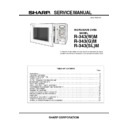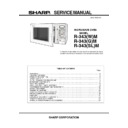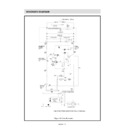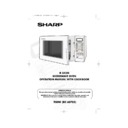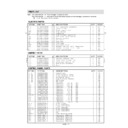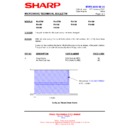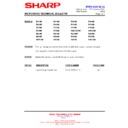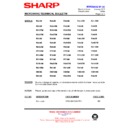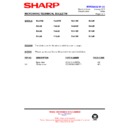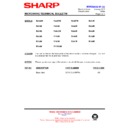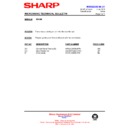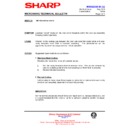Sharp R-343 (serv.man3) Service Manual ▷ View online
R343M - 4
OPERATION DATA
CONNECTED COMPONENTS
RELAY
Oven lamp, Fan motor, Turntable motor
RY1
Power transformer
RY2
OFF CONDITION
Closing the door activates all door interlock switches (latch
switch, monitored latch switch and stop switch).
switch, monitored latch switch and stop switch).
IMPORTANT
When the oven door is closed, the monitor switch contacts
COM - NC must be open.
When the microwave oven is pluged in a wall outlet (230 -
240V 50Hz), the line voltage is supplied to the point A3+A5
in the control unit.
When the oven door is closed, the monitor switch contacts
COM - NC must be open.
When the microwave oven is pluged in a wall outlet (230 -
240V 50Hz), the line voltage is supplied to the point A3+A5
in the control unit.
1. The display flashes ”88:88”.
2. To set any programmes or set the clock, you must first
2. To set any programmes or set the clock, you must first
touch the STOP pad.
3. “ : ” appears in the display.
MICROWAVE COOKING CONDITION
HIGH COOKING
Enter a desired cooking time by touching the Time pads and
start the oven by touching the START pad.
start the oven by touching the START pad.
1. The line voltage is supplied to the primary winding of the
power transformer. The voltage is converted to about
3.3 volts A.C. output on the filament winding and high
voltage of approximately 2000 volts A.C. on the
secondary winding.
3.3 volts A.C. output on the filament winding and high
voltage of approximately 2000 volts A.C. on the
secondary winding.
2. The filament winding voltage (3.3 volts) heats the
magnetron filament and the high voltage (2000 volts) is
sent to the voltagedoubling circuit, where it is doubled to
negative voltage of approximately 4000 volts D.C..
sent to the voltagedoubling circuit, where it is doubled to
negative voltage of approximately 4000 volts D.C..
3. The 2450 MHz microwave energy produced in the
magnetron generates a wave length of 12.24 cm. This
energy is channeled through the waveguide (transport
channel) into the oven cavity, where the food is placed
to be cooked.
energy is channeled through the waveguide (transport
channel) into the oven cavity, where the food is placed
to be cooked.
4. When the cooking time is up, a single tone is heard and
the relays RY1 + RY2 go back to their home position.
The circuits to the oven lamp, power transformer, fan
motor and turntable motor are cut off.
The circuits to the oven lamp, power transformer, fan
motor and turntable motor are cut off.
5. When the door is opened during a cook cycle, the
switches come to the following condition.
The circuits to the power transformer,oven lamp fan
motor and turntable motor are cut off when the monitored
latch switch and stop switch are made open. Shown in
the display is the remaining time.
motor and turntable motor are cut off when the monitored
latch switch and stop switch are made open. Shown in
the display is the remaining time.
6. MONITOR SWITCH CIRCUIT
The monitor switch (SW2) is mechanically controlled by
oven door, and monitors the operation of the monitored
latch switch (SW1)
oven door, and monitors the operation of the monitored
latch switch (SW1)
6-1
When the oven door is opened during or after the
cycle of cooking program, the monitored latch switch
(SW1), and stop switch (SW3) must open their contacts
first. After that the contacts (COM - NC) of the monitor
switch (SW2) can be closed.
cycle of cooking program, the monitored latch switch
(SW1), and stop switch (SW3) must open their contacts
first. After that the contacts (COM - NC) of the monitor
switch (SW2) can be closed.
6-2
When the oven door is closed, the contacts
(COM - NC) of the monitor switch (SW2) must be
opened first. After that the contacts of the monitored
latch switch (SW1) and stop switch (SW3) are closed.
(COM - NC) of the monitor switch (SW2) must be
opened first. After that the contacts of the monitored
latch switch (SW1) and stop switch (SW3) are closed.
6-3
When the oven door is opened and the contacts of the
monitored latch switch (SW1) remain closed, the fuse
(F1) F8A will blow, because the monitor switch is
closed and a short circuit is caused.
monitored latch switch (SW1) remain closed, the fuse
(F1) F8A will blow, because the monitor switch is
closed and a short circuit is caused.
MEDIUM HIGH, MEDIUM, MEDIUM LOW, LOW
COOKING
COOKING
When the microwave oven is preset for variable cooking
power, the line voltage is supplied to the power transformer
intermittently within a 32-second time base through the
relay contact which is coupled with the current-limiting relay
(RY2). The following levels of microwave power are given.
SETTING
power, the line voltage is supplied to the power transformer
intermittently within a 32-second time base through the
relay contact which is coupled with the current-limiting relay
(RY2). The following levels of microwave power are given.
SETTING
CONDITION
DURING
DOOR OPEN
SWITCH
CONTACT
COOKING
(NO COOKING)
Monitored latch switch
COM-NO
Closed
Open
Monitor switch
COM-NC
Open
Closed
Stop switch
COM-NO
Closed
Open
Monitor switch
COM-NO
Closed
Open
NOTE: The ON/OFF time ratio does not exactly correspond
to the percentage of microwave power, because
approx. 3 seconds are needed for heating up the
magnetron filament.
approx. 3 seconds are needed for heating up the
magnetron filament.
32 sec. ON
24 sec. ON
18 sec. ON
12 sec. ON
6 sec. ON
8 sec. OFF
14 sec. OFF
20 sec. OFF
26 sec. OFF
HIGH
MEDIUM HIGH
MEDIUM
MEDIUM LOW
LOW
Approx. 70% = 630 Watts
100%
Approx. 50% = 450 Watts
Approx. 30% = 270 Watts
Approx. 10% = 90 Watts
= 900 Watts
R343M - 5
DOOR OPEN MECHANISM
FUNCTION OF IMPORTANT COMPONENTS
Figure D-1. Door Open Mechanism
LATCH
HEADS
HEADS
LATCH HOOK
MONITOR
SWITCH (SW2)
SWITCH (SW2)
MONITORED
LATCH
SWITCH (SW1)
LATCH
SWITCH (SW1)
STOP
SWITCH
(SW3)
SWITCH
(SW3)
DOOR OPEN BUTTON
OPEN LEVER
DOOR
MONITORED LATCH SWITCH SW1
STOP SWITCH SW3
1. When the oven door is closed, the contacts (COM-
NO) must be closed.
2. When the oven door is opened, the contacts (COM-
NO) must be opened.
MONITOR SWITCH SW2
I
f the oven door is opened and the contacts
(COM-NO) of the monitored latch switch SW1
fail to open, the fuse F8A blows
simultaneously with closing the contacts
(COM-NC) of the monitor switch SW2.
fail to open, the fuse F8A blows
simultaneously with closing the contacts
(COM-NC) of the monitor switch SW2.
CAUTION: BEFORE REPLACING A BLOWN
FUSE F8A TEST THE MONITORED
LATCH SWITCH SW1, MONITOR
SWITCH SW2.
LATCH SWITCH SW1, MONITOR
SWITCH SW2.
MICROWAVE OUTPUT POWER (IEC-60705)
The power output of this oven is rated using the method specified by IEC-60705. Full details of how to carry out this
procedure can be found in the Sharp Technical Training notes which is available from Sharp Parts Centre
(part number SERV-LITMW01).
procedure can be found in the Sharp Technical Training notes which is available from Sharp Parts Centre
(part number SERV-LITMW01).
The IEC-60705 procedure must be carried out using laboratory-type procedures and equipment. These requirements
make the procedure unsuitable for routine performance checks.
make the procedure unsuitable for routine performance checks.
Note: The following test method gives an indication of the output power only, it cannot be used to establish the actual/
rated output power. If the true output power is required, then the IEC-60705 test method must be used.
Alternative simplified method:
1. Place 2 litres of cold water (between 12
1. Place 2 litres of cold water (between 12
°
C and 20
°
C) in a suitable container.
2. Stir the water and measure the temperature in
°
C. Note temperature as T1.
3. Place the container in the microwave and heat the water for 2 minutes on full power.
4. When the 2 minutes is completed, remove the container and stir the water. Note the water temperature as T2.
5. Calculate the output power using the following formula:
4. When the 2 minutes is completed, remove the container and stir the water. Note the water temperature as T2.
5. Calculate the output power using the following formula:
R.F. Power Output = (T2 - T1) x 80.
MICROWAVE LEAKAGE TEST
This oven should be tested for microwave leakage on completion of any repair or adjustment, following the procedure
described in the Sharp Technical Training notes (part number SERV-LITMW01). The maximum leakage permitted in
BS EN 60335-2-25 is 50W/m
described in the Sharp Technical Training notes (part number SERV-LITMW01). The maximum leakage permitted in
BS EN 60335-2-25 is 50W/m
2
(equivalent to 5mW/cm
2
), however it is not normal to detect any significant leakage,
therefore, any leakage which is detected should be investigated.
It is essential that only leakage detectors with current calibration traceable to the National Physical Laboratories are
used.
Suitable leakage detectors :
CELTEC A100
APOLLO X1
APOLLO X1
OUTPUT POWER TEST PROCEDURE
R343M - 6
TEST PROCEDURES
PROCEDURE
LETTER
A TOUCH CONTROL PANEL ASSEMBLY TEST
COMPONENT TEST
Remove the outer case and check voltage between Pin No 5 of the 3 pin connector (A) and common terminal
of the relay (RY2) on the control unit with an A.C. voltmeter.
The meter should indicate rated voltage, if not check oven circuit.
of the relay (RY2) on the control unit with an A.C. voltmeter.
The meter should indicate rated voltage, if not check oven circuit.
RY1 and RY2 Relay Test
These relays are operated by D.C. voltage
Check voltage at the relay coil with a D.C. voltmeter during the microwave cooking operation.
These relays are operated by D.C. voltage
Check voltage at the relay coil with a D.C. voltmeter during the microwave cooking operation.
DC. voltage indicated ............. Defective relay.
DC. voltage not indicated ....... Check diode which is connected to the relay coil. If diode is good, control unit
DC. voltage not indicated ....... Check diode which is connected to the relay coil. If diode is good, control unit
is defective.
RELAY SYMBOL OPERATIONAL VOLTAGE CONNECTED COMPONENTS
RY1
Approx. 19.0V D.C.
Oven lamp / Turntable motor / Cooling fan motor
RY2
Approx. 7.5V D.C.
Power transformer
To prevent an electric shock. Do not touch the electrical parts and the printed wiring
board. Because the control unit is " TRANSLESS CIRCUIT " and all electrical parts
are used at A.C. line voltage.
board. Because the control unit is " TRANSLESS CIRCUIT " and all electrical parts
are used at A.C. line voltage.
C
RELAY TEST
1. Disconnect the oven from the power supply.
2. Discharge the high voltage capacitor.
3. Remove the control unit from the control panel.
4. By using an ohmmeter, check the tact switch operation.
5. When the tact switch is not depressed, an ohmmeter should indicate an open circuit. When the tact
2. Discharge the high voltage capacitor.
3. Remove the control unit from the control panel.
4. By using an ohmmeter, check the tact switch operation.
5. When the tact switch is not depressed, an ohmmeter should indicate an open circuit. When the tact
switch is depressed, an ohmmeter should indicate a short circuit. If improper operation is indicated,
the tact switch is probably defective and should be checked.
the tact switch is probably defective and should be checked.
B
TACT SWITCH TEST
The touch control panel consists of circuits including semiconductors such as LSI, ICs, etc. Therefore, unlike
conventional microwave ovens, proper maintenance can not be performed with only a voltmeter and ohmmeter.
In this service manual, the touch control panel assembly is in one unit and troubleshooting by unit replacement
is described according to the symptoms indicated.
Control Panel.
conventional microwave ovens, proper maintenance can not be performed with only a voltmeter and ohmmeter.
In this service manual, the touch control panel assembly is in one unit and troubleshooting by unit replacement
is described according to the symptoms indicated.
Control Panel.
The following symptoms indicate a defective control unit.
1. Tact Switch.
The following symptoms indicate a defective tact switch. Replace the tact switch.
a) When touching a tact switch, a certain tact switch produces no signal at all.
b) When touching a tact switch, sometimes a tact switch produces no signal.
b) When touching a tact switch, sometimes a tact switch produces no signal.
2. In connection with tact switches.
a) When touching a tact switch, a certain group of tact switch do not produce a signal.
b) When touching a tact switch, no tact switch produce a signal.
b) When touching a tact switch, no tact switch produce a signal.
3. Display problems.
a) At a certain digit, all or some segments do not light up.
b) At a certain digit, brightness is low.
c) Only one indicator does not light up.
d) The corresponding segments of all digits do not light up; or they continue to light up.
e) Wrong figure appears.
f) A certain group of indicators do not light up.
g) The figure of all digits flicker.
h) When touching a tact switch, the control unit does not respond.
b) At a certain digit, brightness is low.
c) Only one indicator does not light up.
d) The corresponding segments of all digits do not light up; or they continue to light up.
e) Wrong figure appears.
f) A certain group of indicators do not light up.
g) The figure of all digits flicker.
h) When touching a tact switch, the control unit does not respond.
4. Other possible problems caused by defective control unit.
a) Buzzer does not sound or continues to sound.
CAUTION
R343M - 7
To protect the electronic circuits, this model is provided with a fine foil pattern added to the input circuit on the PWB, this foil
pattern acts as a fuse. If the foil pattern is open, follow the troubleshooting guide given below for repair.
Problem: POWER ON, indicator does not light up.
pattern acts as a fuse. If the foil pattern is open, follow the troubleshooting guide given below for repair.
Problem: POWER ON, indicator does not light up.
STEPS
OCCURRENCE
CAUSE OR CORRECTION
1
The rated voltage is not applied between Pin
Check supply voltage and oven power cord.
No. 5 of the 3 pin connector (A) and the
common terminal of the relay RY2.
2
Only pattern at "a" is broken.
*Insert jumper wire J1 and solder.
3
Pattern at "a" and "b" are broken.
*Insert the coil RCILF2003YAZZ between "c" and "d".
NOTE: *At the time of making these repairs, make a visual inspection of the varistor. Check for burned damage. If
any abnormal condition is detected, replace the defective parts.
TEST PROCEDURES (CONT'D)
PROCEDURE
LETTER
COMPONENT TEST
D
PROCEDURES TO BE TAKEN WHEN THE FOIL PATTERN ON THE PRINTED WIRING BOARD
(PWB) IS OPEN
(PWB) IS OPEN
1
5
RY2
(J1)
a
d
c
b
CN-A
RY1
D1
VRS1
D71
ZD71

